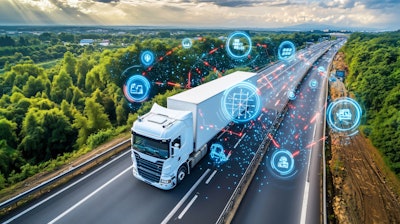
As global trade surges past $33 trillion annually, the freight and transportation industry finds itself at a crossroads. Many marine, rail, trucking, and 3PL companies are absorbing a significant array of changes and have big bets to make.
The pace of change – including shifting trade policies, port congestion, extreme weather disruption, and other geopolitical issues – puts significant pressure on shippers and logistics networks. Amid shifting economic headwinds, there is a lot of uncertainty.
Against this backdrop, Deloitte’s latest report on “The Future of Freight” identifies six interwoven forces set to reshape the industry. As investors, boards and leaders weigh their options, one key to staying on a successful path is remaining agile and open to multiple futures, rather than gambling on a single scenario.
1. Nearshoring: proximity could reduce risk
Shifting trade policies compounded by COVID-19 pandemic-era lessons seem to have energized nearshoring initiatives, putting manufacturing closer to markets. Foreign direct investment is on the rise near Western Europe with a 62% increase in Central, Eastern Europe, and North Africa. Simultaneously, the world seems to be contracting. U.S. trade value between Mexico and Canada saw an 8% rise to $134 billion from January 2024 to January 2025. This realignment could open new corridors and opportunities for trucking, rail, and third-party logistics providers, but also could demand new agility since trade and tax policy can impact the pace of these changes.
Climate concerns can also impact the case for globalized supply chains, which can impose a toll on the environment. Extreme weather and environmental shifts may introduce new unpredictability into long-distance and near-shore maritime shipping.
2. Technology and data: freight gets smarter
Rapid digitization is transforming the material world, including how freight moves. AI and advanced analytics are increasingly streamlining route planning, shipment tracking, and asset management. Yet while 75% of supply chain leaders have piloted new Generative AI applications, their deployments remain limited in impact, according to Deloitte’s report, “Gen AI Transforming Transportation: Lessons from the Frontier of an Emerging Technology.” The problem may be a matter of pace, not promise: The report also found that nearly all transportation executives (99%) expect the technology to transform their industry, but more than two-thirds (71%) expect this transformation to take more than three years, which is slower than several other industries. Questions remain around how to structure technology partnerships to accelerate the pace and impact of artificial intelligence, cloud, Software-as-a-Service, and other contemporary technologies.
3. New competitive dynamics: innovation from all sides
Competition is intensifying not just from startups or tech disruptors, but also from industry giants reinventing themselves. Investment in blockchain is expected to be part of the recipe for competition, potentially providing all parties in the supply chain with the ability to track the location and status of shipments in real time. Some freight brokers have experienced a transformation with the emergence of load boards that apply AI and digital matching platforms. The distributed ledger technology is projected to save the industry up to $31 billion by 2030. Meanwhile, the last-mile delivery market is on track for a $200 billion expansion by 2028, driven by exceptional growth in e-commerce. The winners will likely be those who blend experience with innovation, leveraging both scale and agility.
4. Restructuring: markets in motion
The drumbeat of mergers, acquisitions, restructurings, and strategic divestments remains a constant as many companies seek operational resilience and shareholder value. Thirty-five deals over $1 billion are pending regulatory approval in the United States alone. Strategic restructuring can offer an edge in adapting to labor, regulatory, and market shifts. Now, two companies in the U.S. commercial rail industry proposed a merger to create transcontinental railroad.
5. Fleet transformation: promise and patience
Fleet innovation is accelerating through electrification, automation, and fuel innovation. The global vehicle telematics market is set to grow 8.9% annually, reaching over $170 billion by 2032, while dual-fuel locomotives and electric vehicles expand the possibilities in freight movement. Industry-wide transformation lags, however, amid regulatory uncertainty and capital pressures. In the United States, a company launched its commercial self-driving truck service, delivering 10,000 customer loads across three million autonomous miles in a single state.
6. Public-private partnerships: collaborating for impact
The COVID-19 pandemic laid bare infrastructure vulnerabilities, sparking a surge in public-private partnerships and private equity infrastructure funds. In 2023, private participation in infrastructure projects – e.g., railways, ports, airports – reached $86 billion worldwide, and U.S. infrastructure investment via public-private mechanisms soared from $5 billion in 1999 to $1.3 trillion in 2023 — a robust 26% compound annual growth rate. These collaborations have become important, not only to finance upgrades and manage risks, but also to shape public policy and regulatory frameworks for future-ready logistics networks.
Charting a course forward
Volatility, whether from geopolitics, technology progress, or extreme weather, can create both concerns of financial shocks and chances to invest in new opportunities. Parcel, trucking, and 3PL are likely to sustain more dynamic effects from these forces than ocean and rail, which are generally more consolidated and have higher infrastructure costs.
Regardless of mode, freight and transportation industry leaders should consider investing time and effort into government partnerships and robust scenario planning. It can be beneficial to continuously strategize options, game out outcomes, and continually reassess. Inaction or passivity can limit strategic options and possibilities for value creation. Organizations willing to adapt, innovate, and partner boldly could be better positioned for future success.
This article contains general information only and Deloitte is not, by means of this article, rendering accounting, business, financial, investment, legal, tax, or other professional advice or services. This article is not a substitute for such professional advice or services, nor should it be used as a basis for any decision or action that may affect your business. Before making any decision or taking any action that may affect your business, you should consult a qualified professional advisor.
Deloitte shall not be responsible for any loss sustained by any person who relies on this article.




















